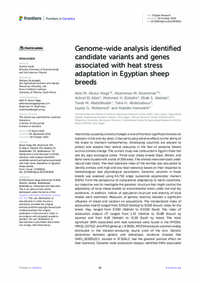Genome-wide analysis identified candidate variants and genes associated with heat stress adaptation in Egyptian sheep breeds

Authors:
Heat stress caused by climatic changes is one of the most significant stresses on livestock in hot and dry areas. It has particularly adverse effects on the ability of the breed to maintain homeothermy. Developing countries are advised to protect and prepare their animal resources in the face of potential threats such as climate change. The current study was conducted in Egypt’s three hot and dry agro-ecological zones. Three local sheep breeds (Saidi, Wahati, and Barki) were studied with a total of 206 ewes. The animals were exercised under natural heat stress. The heat tolerance index of the animals was calculated to identify animals with high and low heat tolerance based on their response to meteorological and physiological parameters. Genomic variation in these breeds was assessed using 64,756 single nucleotide polymorphic markers (SNPs). From the perspective of comparative adaptability to harsh conditions, our objective was to investigate the genomic structure that might control the adaptability of local sheep breeds to environmental stress under hot and dry conditions. In addition, indices of population structure and diversity of local breeds were examined. Measures of genetic diversity showed a significant influence of breed and location on populations. The standardized index of association (rbarD) ranged from 0.0012 (Dakhla) to 0.026 (Assuit), while for the breed, they ranged from 0.004 (Wahati) to 0.0103 (Saidi). The index of association analysis (Ia) ranged from 1.42 (Dakhla) to 35.88 (Assuit) by location and from 6.58 (Wahati) to 15.36 (Saidi) by breed. The most significant SNPs associated with heat tolerance were found in the MYO5A, PRKG1, GSTCD, and RTN1 genes (p ≤ 0.0001). MYO5A produces a protein widely distributed in the melanin-producing neural crest of the skin. Genetic association between genetic and phenotypic variations showed that OAR1_18300122.1, located in ST3GAL3, had the greatest positive effect on heat tolerance. Genome-wide association analysis identified SNPs associated with heat tolerance in the PLCB1, STEAP3, KSR2, UNC13C, PEBP4, and GPAT2 genes.
